Blockchain technology revolutionizes ownership by utilizing a decentralized ledger that securely records transactions, making it nearly impossible to alter ownership records. Its robust security features, including cryptographic hashing and consensus mechanisms, ensure data integrity and prevent unauthorized access. Additionally, the distributed nature of blockchain, maintained by a network of nodes, enhances transparency and eliminates centralized control.
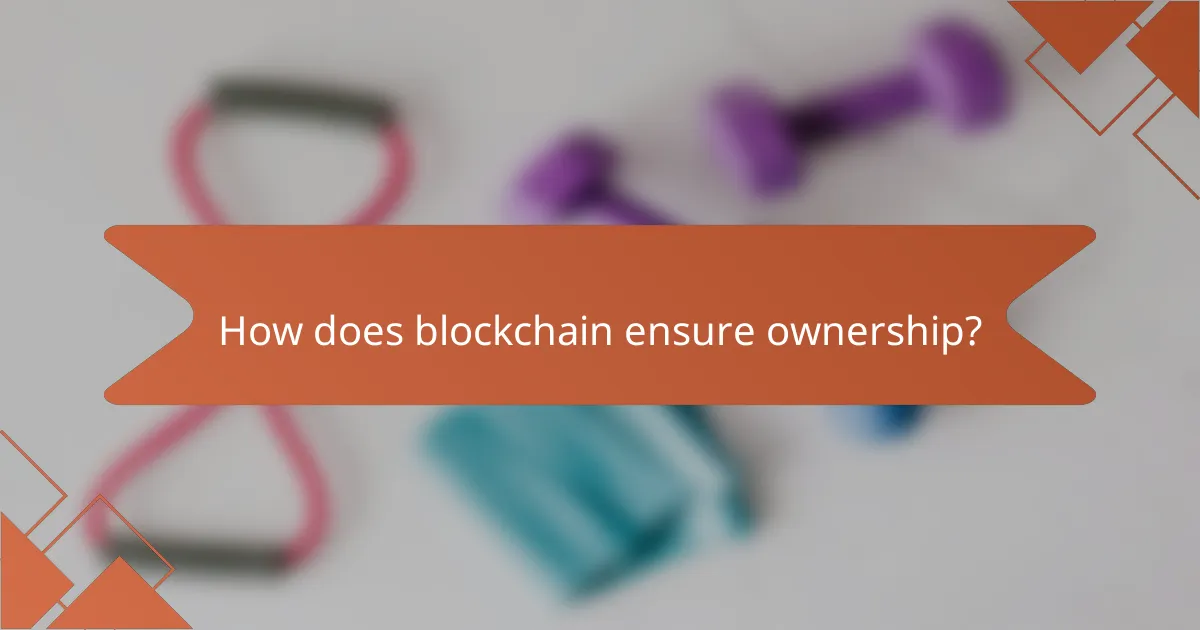
How does blockchain ensure ownership?
Blockchain ensures ownership through its unique structure that records transactions on a decentralized ledger, making it nearly impossible to alter or counterfeit ownership records. This technology provides a transparent and secure method for verifying ownership of digital and physical assets.
Decentralized ledger technology
Decentralized ledger technology (DLT) is the backbone of blockchain, allowing multiple participants to access and verify the same data without a central authority. Each transaction is recorded in blocks that are linked together, creating an immutable chain that enhances security and trust among users.
This decentralized approach reduces the risk of fraud and manipulation, as no single entity controls the entire network. For example, in real estate transactions, buyers and sellers can verify ownership and transaction history without relying on intermediaries like banks or notaries.
Smart contracts for verification
Smart contracts are self-executing contracts with the terms of the agreement directly written into code. They automatically enforce and execute the terms when predetermined conditions are met, providing a reliable way to verify ownership and transfer assets without human intervention.
For instance, in a blockchain-based property sale, a smart contract can automatically transfer ownership once payment is confirmed, ensuring that both parties fulfill their obligations. This reduces the need for legal intermediaries and speeds up the transaction process.
Tokenization of assets
Tokenization involves converting ownership of real-world assets into digital tokens on a blockchain. Each token represents a share of the asset, making it easier to trade and transfer ownership while ensuring transparency and security.
For example, a piece of artwork can be tokenized, allowing multiple investors to own fractions of it. This democratizes access to high-value assets and enables more efficient transactions, as tokens can be traded on various platforms without the complexities of traditional ownership transfers.
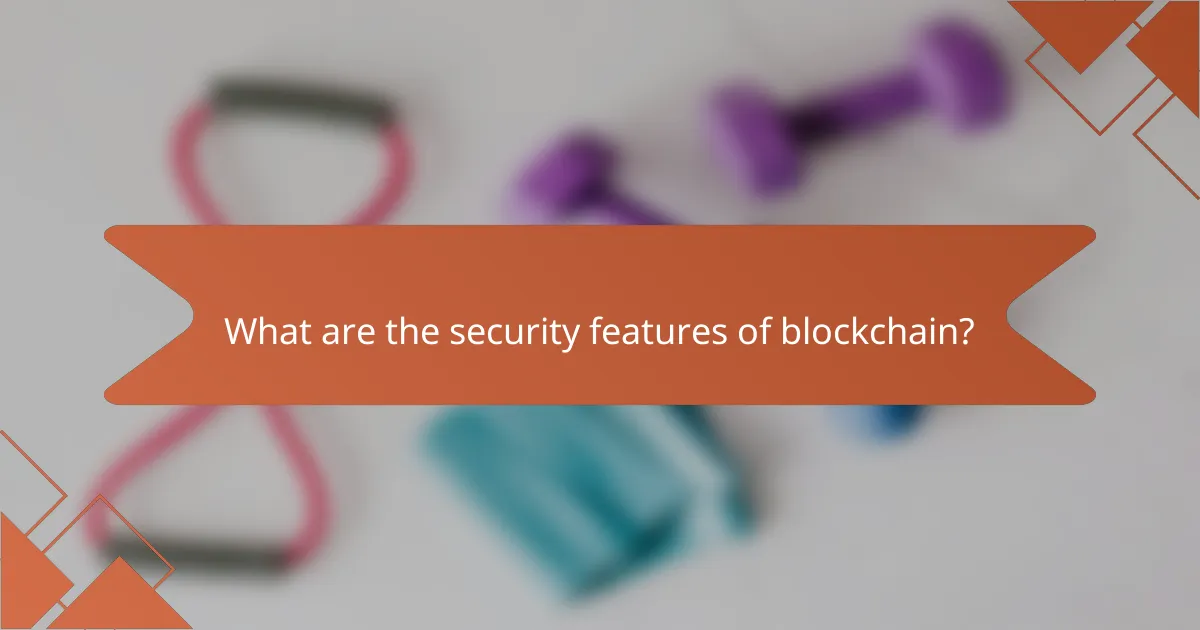
What are the security features of blockchain?
Blockchain technology incorporates several key security features that enhance its reliability and trustworthiness. These features include cryptographic hashing, consensus mechanisms, and the immutability of records, all of which work together to protect data integrity and prevent unauthorized access.
Cryptographic hashing
Cryptographic hashing is a fundamental security feature of blockchain that transforms input data into a fixed-size string of characters, which appears random. This process ensures that even a slight change in the input will produce a significantly different hash, making it nearly impossible to alter data without detection.
For example, Bitcoin uses the SHA-256 hashing algorithm, which generates a unique hash for each block of transactions. This not only secures the data but also links blocks together, creating a chain that is resistant to tampering.
Consensus mechanisms
Consensus mechanisms are protocols that ensure all participants in the blockchain network agree on the validity of transactions. They prevent double-spending and maintain the integrity of the blockchain by requiring a majority of nodes to confirm any changes.
Popular consensus mechanisms include Proof of Work (PoW) and Proof of Stake (PoS). PoW, used by Bitcoin, requires miners to solve complex mathematical problems, while PoS, used by Ethereum 2.0, allows validators to create new blocks based on the number of coins they hold. Each method has its own trade-offs regarding energy consumption and transaction speed.
Immutability of records
The immutability of records in blockchain means that once data is recorded, it cannot be altered or deleted without the consensus of the network. This feature is crucial for maintaining trust, as it ensures that all transactions are permanent and verifiable.
For instance, in supply chain management, once a product’s journey is recorded on a blockchain, all stakeholders can trace its history without fear of tampering. This transparency enhances accountability and can help prevent fraud.
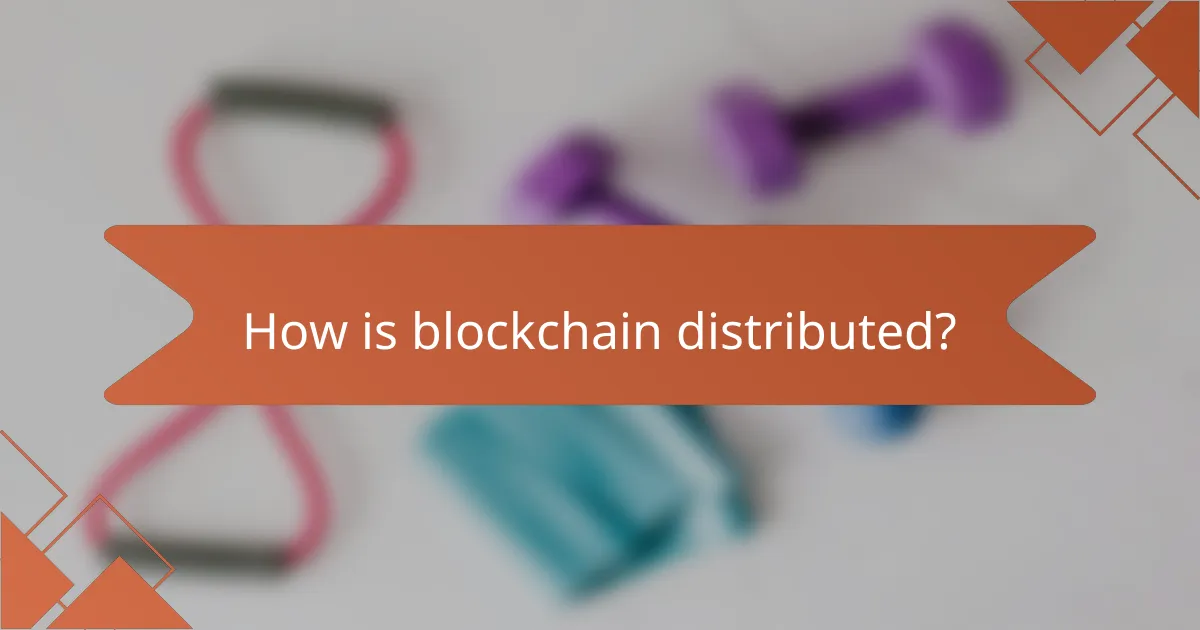
How is blockchain distributed?
Blockchain is distributed through a decentralized network of computers, known as nodes, that collectively maintain and validate the shared ledger. This structure ensures that no single entity has control over the entire network, enhancing security and transparency.
Peer-to-peer network structure
The peer-to-peer network structure of blockchain allows each node to connect directly with others, facilitating the sharing of data without intermediaries. This design promotes resilience, as the failure of one node does not compromise the entire system.
In a typical blockchain network, every participant can access the same information, ensuring consistency across the ledger. This decentralization helps prevent fraud and manipulation, as altering data would require consensus from the majority of nodes.
Node validation processes
Node validation processes are critical for maintaining the integrity of the blockchain. Each node verifies transactions and blocks before they are added to the ledger, using consensus mechanisms like Proof of Work or Proof of Stake.
These processes require nodes to perform computational tasks or stake their cryptocurrency holdings, ensuring that only legitimate transactions are recorded. This not only secures the network but also incentivizes participants to act honestly.
Global accessibility
Blockchain’s global accessibility means that anyone with an internet connection can participate in the network, regardless of their location. This democratizes access to financial services and information, particularly in regions with limited banking infrastructure.
However, users should be aware of local regulations regarding cryptocurrency and blockchain technology, as compliance can vary significantly from one country to another. Understanding these regulations is crucial for safe and legal participation in the blockchain ecosystem.
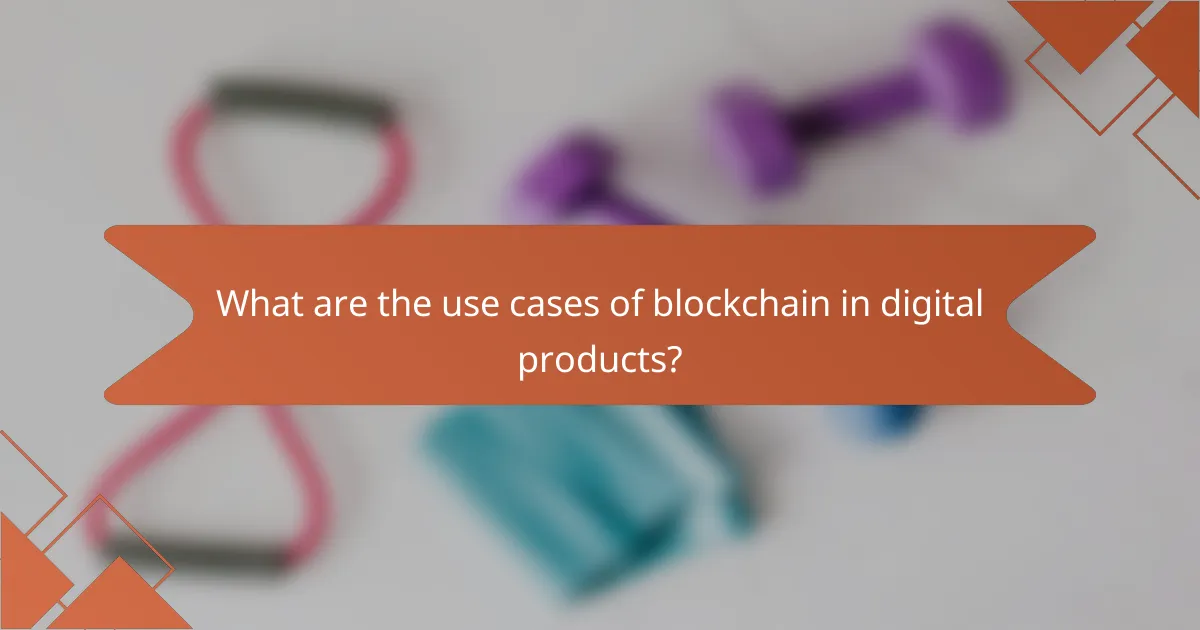
What are the use cases of blockchain in digital products?
Blockchain technology has several impactful use cases in digital products, enhancing transparency, security, and efficiency. Key applications include supply chain management, digital identity verification, and financial transactions, each leveraging blockchain’s decentralized and immutable nature.
Supply chain management
In supply chain management, blockchain provides a transparent and tamper-proof ledger for tracking products from origin to consumer. This technology allows all parties involved to access real-time data, improving accountability and reducing fraud.
For example, companies can trace the journey of food products to ensure safety and quality, while retailers can verify the authenticity of luxury goods. Implementing blockchain can streamline processes, but it requires collaboration among all stakeholders to be effective.
Digital identity verification
Blockchain enhances digital identity verification by allowing individuals to control their personal data securely. Instead of relying on centralized databases, blockchain enables users to store their identities in a decentralized manner, reducing the risk of data breaches.
Organizations can use blockchain to verify identities quickly and accurately, which is particularly useful in sectors like finance and healthcare. However, it is crucial to establish clear protocols for data privacy and compliance with regulations like GDPR.
Financial transactions
Blockchain revolutionizes financial transactions by enabling peer-to-peer transfers without intermediaries, leading to faster and cheaper transactions. This technology supports cryptocurrencies and smart contracts, which automate and enforce agreements without the need for a trusted third party.
For instance, cross-border payments can be completed in minutes instead of days, significantly reducing transaction costs. Businesses should consider the regulatory landscape and potential volatility of cryptocurrencies when integrating blockchain into their financial systems.
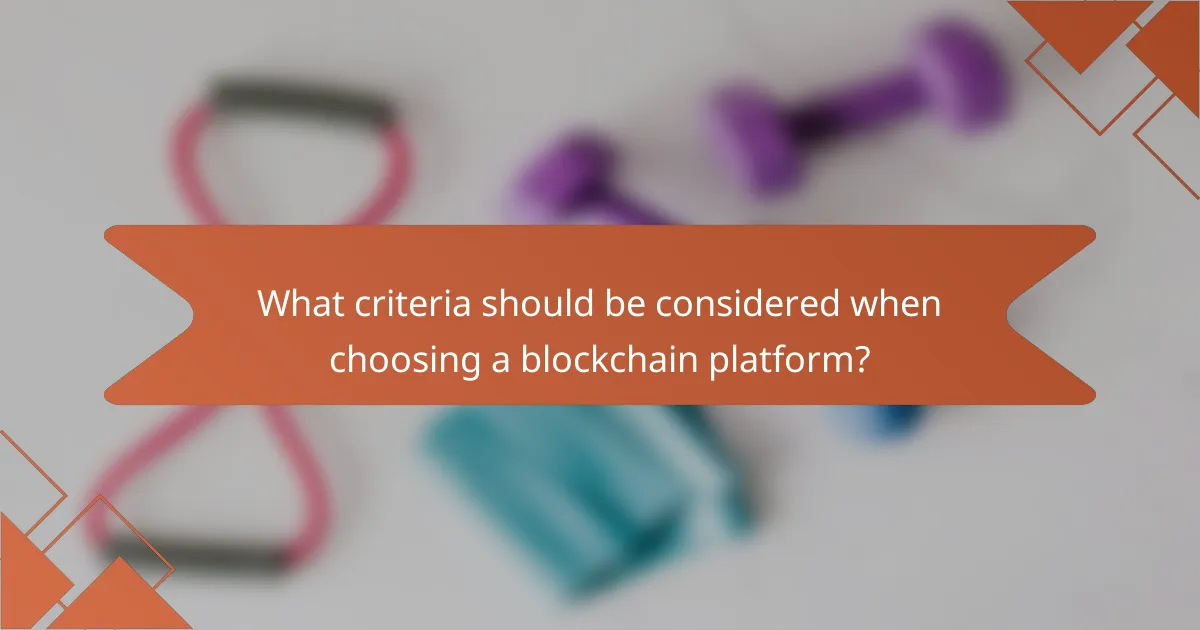
What criteria should be considered when choosing a blockchain platform?
When selecting a blockchain platform, consider factors such as scalability, security, and community support. These elements significantly influence the platform’s performance, reliability, and long-term viability for your project.
Scalability options
Scalability refers to a blockchain’s ability to handle an increasing number of transactions efficiently. Look for platforms that offer various scalability solutions, such as sharding or layer-2 protocols, which can enhance transaction throughput without compromising security.
For example, Ethereum 2.0 is implementing sharding to improve scalability, while platforms like Polygon provide layer-2 solutions that allow for faster transactions at lower costs. Assess the expected transaction volume of your application to choose a platform that can grow with your needs.
Security protocols
Security is paramount in blockchain technology, as vulnerabilities can lead to significant financial losses. Evaluate the security protocols employed by the platform, such as consensus mechanisms (e.g., Proof of Work vs. Proof of Stake) and encryption standards.
Platforms like Bitcoin utilize a robust Proof of Work mechanism, while others, like Cardano, use Proof of Stake, which may offer energy efficiency benefits. Ensure that the platform has undergone thorough security audits and has a history of resilience against attacks.
Community support and development
A strong community and active development are crucial for the ongoing success of a blockchain platform. Look for platforms with vibrant developer communities that contribute to continuous improvements and provide support.
Platforms like Ethereum have extensive documentation and a large number of developers, which can facilitate troubleshooting and innovation. Engaging with community forums and resources can help you gauge the level of support available for your chosen platform.

What are the challenges of implementing blockchain technology?
Implementing blockchain technology presents several challenges, including regulatory compliance, interoperability with existing systems, and energy consumption. Addressing these issues is crucial for successful adoption and integration into various sectors.
Regulatory compliance issues
Regulatory compliance is a significant challenge for blockchain technology, as laws and regulations vary widely across jurisdictions. Companies must navigate complex legal landscapes to ensure their blockchain applications meet local and international standards.
For instance, financial institutions may face stringent regulations regarding data privacy and anti-money laundering (AML) practices. It is essential to stay updated on evolving regulations and engage with legal experts to mitigate risks associated with non-compliance.
Interoperability with existing systems
Interoperability refers to the ability of blockchain systems to communicate and work with existing technologies. Many organizations struggle to integrate blockchain with their current infrastructure, which can hinder its effectiveness.
To address this, companies should assess their existing systems and identify potential integration points. Utilizing middleware solutions or adopting blockchain platforms that support interoperability can facilitate smoother transitions and enhance overall functionality.
Energy consumption concerns
Energy consumption is a growing concern associated with blockchain technology, particularly with proof-of-work consensus mechanisms. These systems can require significant computational power, leading to high energy usage and environmental impacts.
Organizations should consider adopting more energy-efficient consensus algorithms, such as proof-of-stake or delegated proof-of-stake, which can reduce energy consumption significantly. Additionally, exploring renewable energy sources for mining operations can further mitigate environmental concerns.
